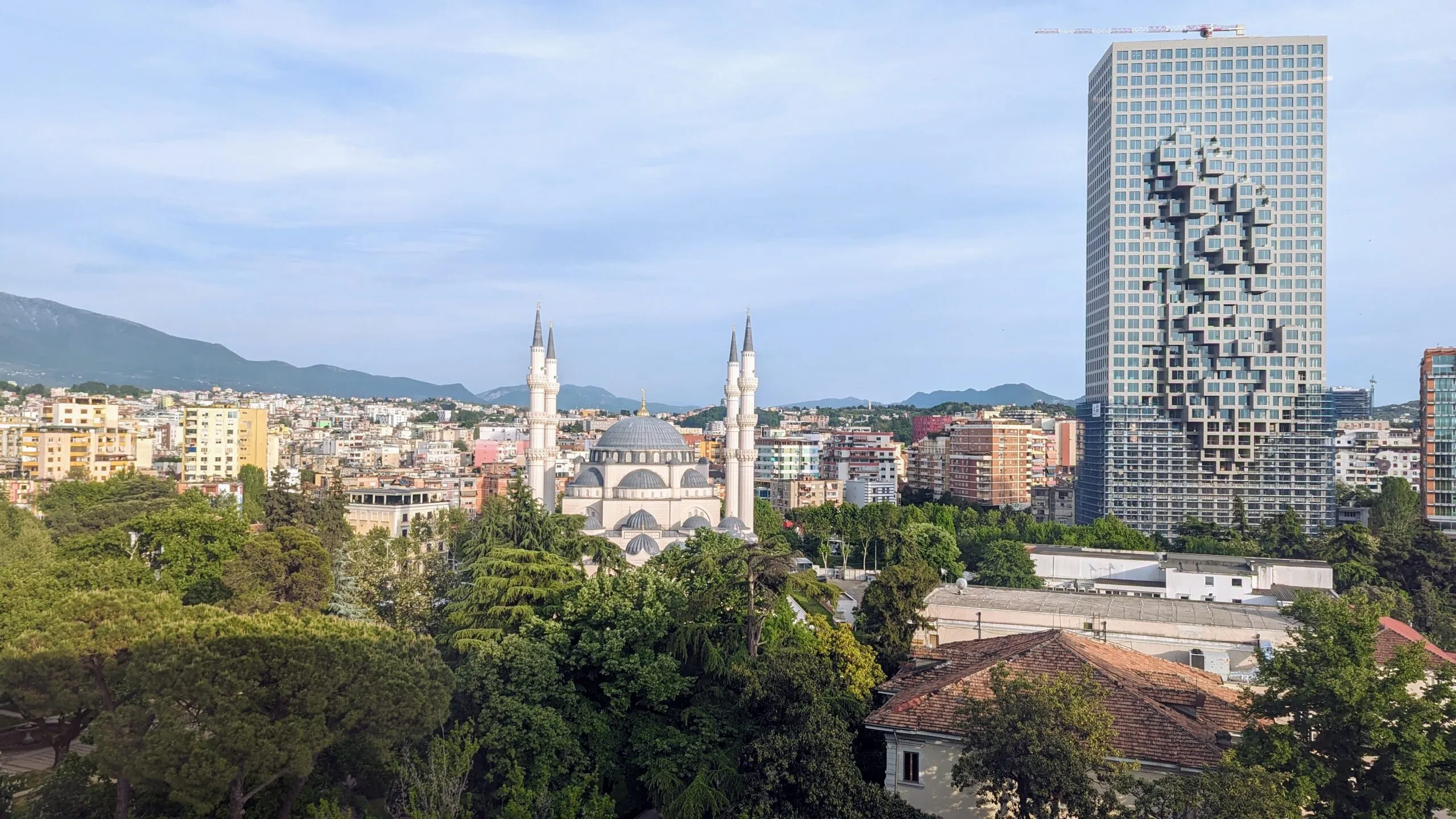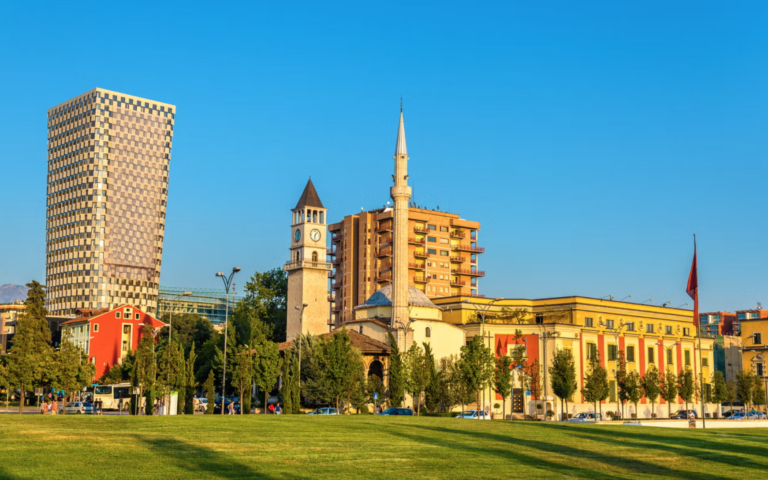Tirana, the most attractive city in Balkan Peninsula, is specially designed for curious tourists who want to experience its life and its peculiarities.
Tirana offers a completely different spirit than the surrounding countryside. Tirana, the capital of a small country and also one of the most beautiful European cities, is a very interesting place to visit, rich in references, monuments, historical and cultural sites.
1. Embark on a leisurely walk through Skanderbeg Square
Tirana’s most renowned square, spanning an impressive 430,000 square meters, pays homage to Albania’s national hero. This bustling plaza serves as an ideal location to partake in live events, engage in people-watching, and explore the adjacent landmarks, such as the National Opera, the National Library, and the towering 36-foot Skanderbeg Statue.
Skanderbeg Square serves as a popular starting point for diverse city walking tours, ranging from a brisk 90 minutes to extensive journeys exceeding 3 hours. These tours cater to various interests, including architectural explorations of Tirana’s distinctive fusion of Ottoman, European, and Soviet-era buildings, as well as food market tours offering a taste of traditional Albanian cuisine. Short on time with just an hour to spare? City highlights tours guide you through Tirana’s main landmarks and points of interest.
Nearby, on the fringes of Rinia Park, stands the vibrant “I Love Tirana” sign, a symbol of the city’s warm hospitality. This colorful spot is not only a favorite year-round for striking photographs but also a delightful and welcoming destination to visit.
2. Explore Albania’s History at the National Historical Museum
Spanning an expansive exhibition space of over 193,000 square feet, the National Historical Museum stands as the largest museum in Albania. Its extensive collection, featuring over 5,000 artifacts, is thoughtfully organized across eight pavilions, each devoted to distinct historical or social periods. The thematic areas encompass the Middle Ages, the Ottoman period, Albania’s Independence, post-Byzantine religious icons, and the Communist Persecution period from 1945 to 1990.
These pavilions offer a chronological journey through Albania’s past, utilizing art, mosaics, Roman artifacts, and relics from national heroes who sacrificed their lives in the fight against Fascism and Nazism. The inclusion of documents and historical photographs contributes to a comprehensive retelling of the country’s history. The Pavilion of Antiquity specifically focuses on archaeological artifacts from the 4th to the 2nd century AD, showcasing Greek and Roman coins among its treasures.
Adding a grandeur to the exterior, a massive mural illustrates significant historical events in Albania, capturing the essence of the nation’s storied past. The National Historical Museum is a captivating destination for those eager to delve into the rich tapestry of Albania’s history.
3. Drink a coffee at Tirana Castle
8. Immerse Yourself in Nature at Tirana’s Finest Parks
Tirana offers a diverse array of enchanting parks, catering to various preferences and interests for the entire family.
The Grand Park of Tirana, the city’s largest, graces the edge of an artificial lake, inviting joggers, picnickers, and those seeking a leisurely stroll to its serene surroundings.
For a nature retreat just six miles from the city center, Farka Lake Park presents itself around a sizable artificial lake, providing breathtaking views of the surrounding mountains. This verdant haven beckons those yearning to escape the urban hustle, offering activities such as hiking, biking, boating, and swimming, with a narrow beach encircling the lake.
Nestled in the heart of the city, Parku Rinia – Youth Park sprawls across 7.4 acres and is renowned for hosting festivals and live music. The Taivani (or Taiwan Center) complex, adjacent to the park’s expansive fountain, boasts cafés, restaurants, and even a bowling alley.
A noteworthy addition to your park exploration is Lulishte Ismail Qemali, a compact yet compelling space housing a segment of the Berlin Wall, an underground bunker, and Postblloku—a poignant memorial dedicated to the victims of communism in Albania. Tirana’s best parks promise a harmonious blend of nature, culture, and recreational opportunities for a truly enriching experience.
9. Embark on a Scenic Hike to Bovilla Lake
Nestled at the base of Gamti Mountain and just a 1.5-hour drive from Tirana, Bovilla Lake beckons as an ideal destination for a day trip. Whether opting for a self-guided adventure (requiring a rented car for access) or joining one of the numerous guided tours from Tirana, this pristine lake promises a memorable experience.
Upon reaching the trailhead, follow the well-defined path, relishing in panoramic vistas and breathtaking cliffs along the ascent. Upon arriving at the lake, seize the opportunity to unwind, enjoy a picnic, or simply bask in the natural beauty before descending back.
For those seeking a more exhilarating escapade, consider tours organized as an alternative means to explore the lake’s surroundings. With an array of off-road trails and captivating sights, this daily trip offers an adventurous perspective from behind the wheel.
10. Experience Shopping and Dining Delights at the New Bazaar (Pazari i Ri)
Pazari i Ri, affectionately known as the New Bazaar, stands as the go-to destination for locals seeking fresh produce and authentic Albanian goods. It offers a diverse array of dining options, allowing you to savor the richness of Albanian cuisine at a fraction of the cost compared to local restaurants. Operating in the area since Ottoman times, the market has undergone extensive renovations in recent decades.
Today, the New Bazaar boasts an enticing array of Albanian wines, local spices, cheeses, and olives. For those in search of traditional Albanian crafts and souvenirs, the market proves to be a treasure trove.
After securing mementos to bring home, indulge in Albanian culinary delights at one of the market’s numerous restaurants or cafés. Try classic offerings such as byrek (a savory pie) and grilled meats to tantalize your taste buds. Before leaving, be sure to grab some quick local pastries or other snacks to enjoy on the go. The New Bazaar promises a delightful fusion of shopping and dining experiences in the heart of Tirana.
11. Explore the Depths of Pellumbas Cave on a Day Excursion
Embark on a picturesque journey through charming villages and rolling hills, culminating in a 40-minute hike to reach Pellumbas Cave, also known as the Black Cave. Situated just 15 miles from Tirana, this karst cave provides an exhilarating day trip for adventure enthusiasts.
Pellumbas Cave comprises an extensive network of chambers and passageways spanning over 1148 feet, adorned with impressive stalactites and stalagmites. It’s essential to bring a flashlight, as the cave is enveloped in complete darkness. Having served as a habitat as far back as 30,000 years ago, the area is safeguarded, holding the status of a natural monument of national and international significance.
On the return journey, keep a keen eye out for the Erzen River and its breathtaking canyons. Following the river’s course, you’ll encounter a waterfall and a natural pool, offering an inviting opportunity for a refreshing swim or a leisurely toe-dip into the crystal-clear waters. Pellumbas Cave and its scenic surroundings promise a captivating and memorable day escape from Tirana.
12. Immerse Yourself in Spiritual Serenity at the Resurrection of Christ Orthodox Cathedral
For a profound encounter with local culture, a visit to the Resurrection of Christ Orthodox Cathedral stands as a must-do in Tirana. Ranking among the largest orthodox cathedrals in the Balkans, it transcends its religious significance to become a pivotal cultural landmark. Its imposing bell tower, soaring over 150 feet and hosting 16 bells, coupled with a striking white and gold exterior, ensures the cathedral’s prominent presence in the city’s skyline.
Part of an expansive complex, the cathedral includes three chapels, a library, a cultural center, and a small religious museum with an exhibition area. This combination transforms the church into a vibrant cultural hub, drawing both locals and visitors alike. The cathedral itself serves as an artistic showcase, featuring frescoes and intricate gold decor embellishing its interior walls, resembling an immersive art gallery.
13. Explore the Mysterious Pyramid of Tirana
A prominent symbol in the city’s skyline, the Pyramid of Tirana emerged in the 1980s as a museum dedicated to the life of Enver Hoxha. This colossal structure spans an impressive 130,000 square feet, characterized by sloping concrete sides and a substantial glass entrance front.
Following the collapse of communism, the pyramid served briefly as a NATO base during the Kosovo War and later transformed into a nightclub and event space. Over time, graffiti adorned the pyramid’s walls, and its doors were closed.
Despite persistent calls for demolition, the Pyramid of Tirana endures. A new initiative envisions converting the pyramid into a versatile tech hub, with a specific focus on aiding young people. The redesign includes expansive skylights to introduce more natural light and creating accessible steps on the exterior cement slabs for pedestrian access.
Visitors to the area should also make a point to visit the nearby Peace Bell monument. Constructed using gun shells from a significant city unrest in the 1990s, during which hundreds of lives were lost, it stands as a poignant reminder of historical events.
14. Ascend the Time-Honored Clock Tower of Tirana
Constructed in 1822 by the esteemed nobleman and poet Et’hem bey Mollaj, who concurrently contributed to the adjacent Et’hem Bey Mosque, Tirana’s Clock Tower stands as a testament to historical craftsmanship. Originally of shorter stature, it underwent expansion to reach a height of 115 feet, and a new clock was installed in 1928 to replace the one damaged during World War I.
Once a dominant feature in Tirana’s skyline, the clock tower retains its status as a cherished landmark. Visitors have the opportunity to climb the 90 steps leading to its summit, where panoramic views of the city unfold.
Situated just off Skanderberg Square, the clock tower serves as a popular attraction on walking tours of the city and offers a delightful photo opportunity, even for those who choose not to venture inside.
15. Explore Enver Hoxha’s Former Residence
Nestled in the Blloku neighborhood, Enver Hoxha’s former residence stands as a significant relic from Albania’s communist era. Serving as the heavily guarded compound where Hoxha resided for the four decades of his authoritarian rule, this residence offers insights into the country’s complex history.
Constructed in a brutalist style, the austere three-story building showcases a stark exterior and interior. High walls, expansive rooms, and a soundproof bedroom are just a glimpse into the peculiar details found within. Notably, Hoxha had a tunnel constructed, connecting his basement to an underground bunker as a precautionary measure against potential attacks.
Following Hoxha’s assassination in 1985, the mansion was sealed and remained abandoned for years. Although it underwent cleanup and preservation efforts, it currently remains closed to the public, sparking divergent opinions on its future use. Presently, visitors can still observe the exterior of the house, often as part of communist tours in Tirana.


